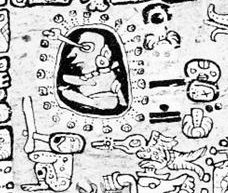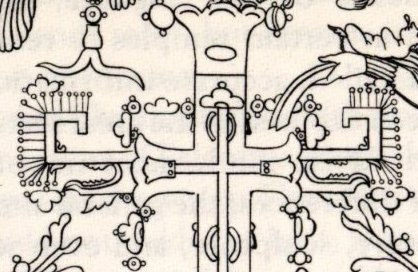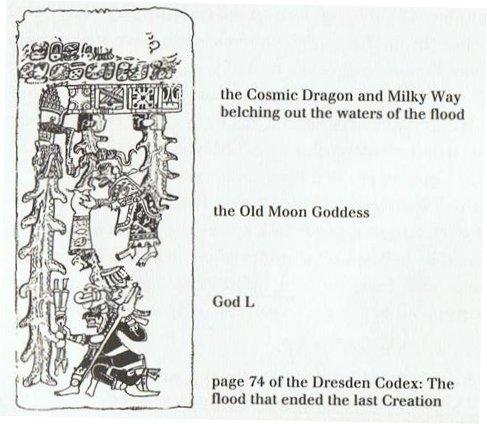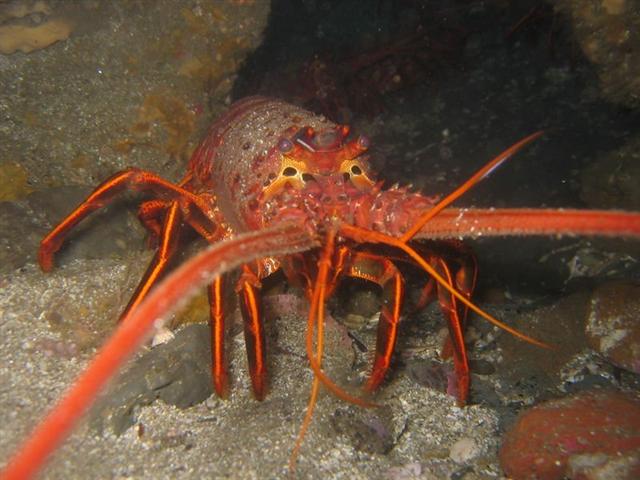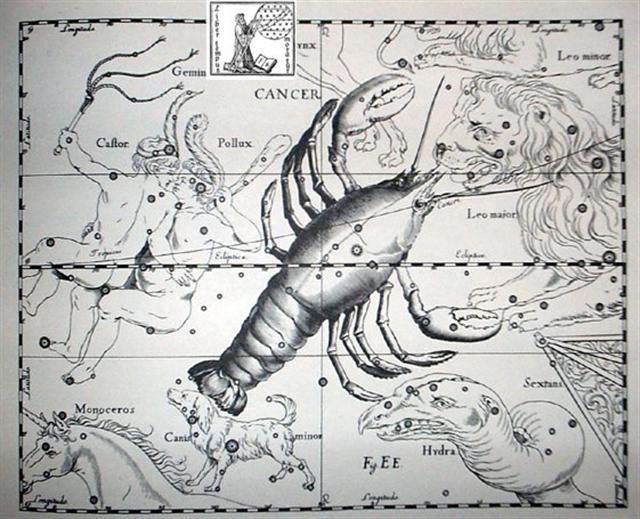Glyph 182 on the C tablet has a kind of 'fruit' (offspring, hua) at its back side and the illuminated Moon cresent (marama) in front. Metoro said: kua hua - ki te marama:
Juggling numbers we can find e.g. 182 + 71 * 4 = 2 * 91 + 284 = 466 = 366 + 100 = 101 + 365. The number of 'feathers' are 3 (high at left) + 3 (low at right) = 6. These feather marks could indicate 'lights in the night-time' (e.g. light months), for instance 3 * 29 = 87 and 6 * 29 = 174 = 364 - 190.
Although it will then become clear that the lights themselves are missing - the months were no longer directly ruled by specific stars. We can compare with how in the Mayan illustration below the lights are still present:
Right ascension night number 182 (= the nakshatra position of Ca7-14), was at 12h.
Here the Sun was half a year away at the location of the 2nd Spout (0h at heliacal Sirrah).
According to Kuihi and Kuaha the intestines (entrails, te kokoma) had been pulled out (i hakauru) by Oroi and in order to accomplish this he had used vaero ura (a lobster's antenna) as instrument (hai).
Hai: 1. With (instrumental). 2. To, towards. He oho hai kona hare, to go home. He oho hai kona hagu, mo kai, to go where there is food to eat. 3. Give me: hai kumara, give me some sweet potatoes. Ha'i: 1.To give, to deliver, to hand over. 2. To carry under the armpit. 3. To hug, to embrace. 4. To wrap up; parcel, packet. Ha'iga, armpit. Haîara, to guide, to direct (someone). Ka haîara koe i taaku poki ki te kona rivariva, guide my son to a good spot. Vanaga. 1. To wrap up, to make into parcels, to envelop; food tied up in bundles (ai). PS Sa.: sai, a tightly bound bundle. To.: haihai, to tie up in a bundle. Fu.: sai, to tie; saisaiga, a bundle. Niuē: hai, to tie fast. 2. To carry, to transport. Ta.: afai, to carry an object, to transport; afafai, capable of carrying a heavy burden, to carry here and there. 3. To be in heat, to copulate, to embrace; concupiscence, fornication, impurity; lascivious, impure (ai). P Ta.: ai, to copulate. Haiga, armpit. PS Sa.: fa'iga, a joint. Haipo, heart; haipo rahirahi, shortness of breath. Mq.: houpo, heart. Haite (ha causative, ite) numeral. Churchill. Pau.: haifa, virile, manly. Ta.: aiaha, a brave young warrior. Churchill. Mgv.: hai, a fish. Ta.: fai, the stingray. Mq.: fai, hai, id. Sa.: fai, id. Ma.: whai, id. Haihai, evening (metathetic). Sa.: afiafi, id. Churchill. Ura, lobster. Ûra, flame, blaze (ûra ahi), to become furious (with manava as subject: ku-ûra-á te manava). Úraúra, bright red. Vanaga. 1. Crayfish, lobster, prawn. P Mgv.: ura, crayfish. Mq.: uá, lobster. Ta.: oura, crayfish, lobster. 2. Fire, burning, to be in flames; uraga, combustion, flame, torch; hakaura, to cause to glow, to kindle, to light. P Mgv., Ta.: ura, a flame, to burn. Mq: uá, id. Uraga, burden, load, weight. Uraura, vermilion, scarlet. P Pau.: kurakura, red. Mgv.: uraura, an inflamed countenance. Mq.: uáuá, red, ruddy. Ta.: uraura, red. Churchill. However, the glyph type which I have named vaero seems to depict something quite different:
Possibly we should perceive the claws of Cance:
|
||||||||||||||||||||||||

